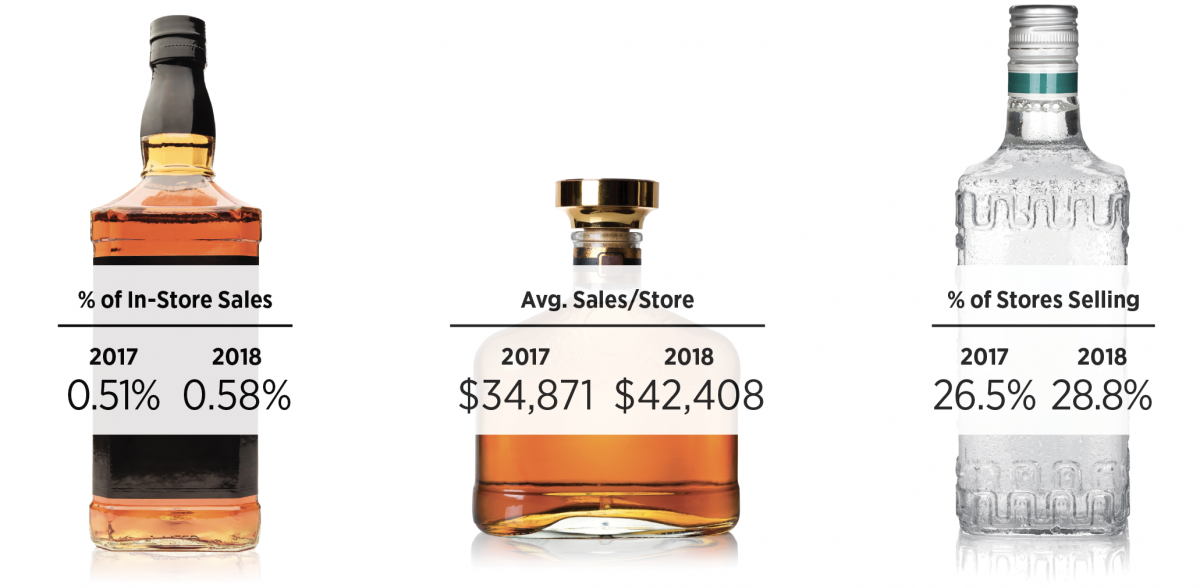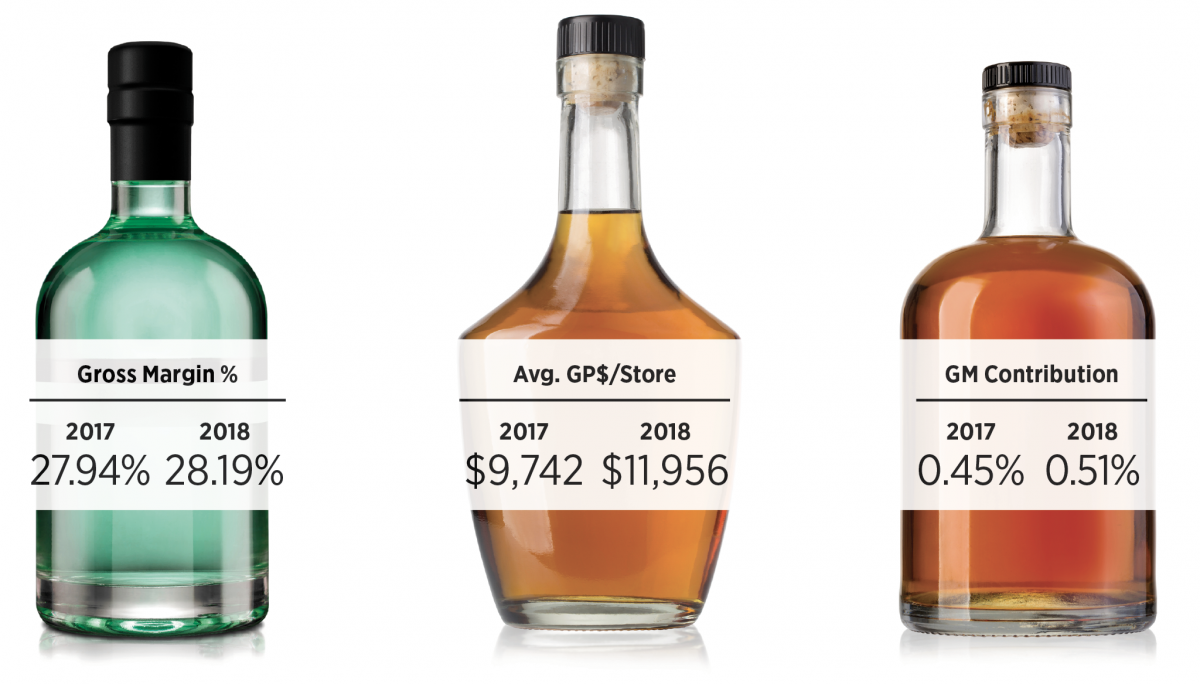Liquor sales in convenience stores are holding their own or even outperforming strong overall national trends for the category. Retailers and suppliers expect the strong showing will continue for the foreseeable future as adult beverage consumers, particularly millennials, increasingly shift their drink preferences toward distilled spirits, and c-store operators place a bigger focus on the products.
Mark Schulte, senior vice president and general manager, national and regional accounts at Diageo North America, said convenience retailers are now more attuned to carrying the right categories and brands “to maximize consumer demand in a limited space environment.” The more defined core assortment has allowed c-store retailers to better compete with other trade channels, Schulte explained.
Indeed, Derek Gaskins, senior vice president of merchandising and procurement at Yesway, reported that through late 2019, the chain was seeing a 25% year-over-year growth rate in liquor sales. Some Yesway locations—such as those in South Dakota—have expansive liquor departments and stock more than 1,000 options, while in other states, selection ranges between 150 to 300 SKUs. Prices span from 99 cents for 50-ml. bottles to more than $150 for high-end brands, Gaskins said. With Yesway’s recent acquisition of Allsup’s, the company is looking to acquire liquor licenses where feasible, he remarked, in an effort to deliver “even more convenience to our consumers.”
The one-unit Iowa Street Market in Dubuque is also capitalizing on the growing trend toward spirits. Owner Jason Norton said he has been expanding selection in recent years and has even been successful in landing bottles of limited-release bourbons. The allocated products can sell for upward of $70 a bottle, Norton said.
Double-Digit Gains
According to NACS State of the Industry Report of 2018 Data, average per-store sales of liquor surged 22% to $42,408 from $34,871 in the year prior, representing one of the best performances of categories tracked, albeit on a small basis. “Liquor is still a pretty small part of overall merchandise sales, accounting for just 0.58% of in-store sales,” remarked Jayme Gough, NACS analyst, noting that only 29% of stores reported selling distilled spirits, generally because of regulatory and market-by-market obstacles. Still, “liquor generates fair margins in the store,” Gough said and brought in nearly $12,000 in gross profit dollars per store in 2018.
Industry Sales

Source: NACS State of the Industry Report of 2018 Data
“Higher-end segments are driving growth,” reported Schulte, resulting in increased tickets per visit and “serving to contradict certain stereotypes of this channel, which endure.” The trading-up trend is particularly noticeable in small-size items such as 375-ml. containers, the Diageo executive continued. Christian Rogers, alcohol category manager at Kum & Go, reported that both premiumization and increased sales of smaller packages are driving strong growth of liquor sales at the midwestern chain. About 200 Kum & Go stores offer spirits, and the chain looks to stock the products in any new stores where it can legally do so, he said.
Rogers and other retailers reported that the revival in whiskey sales is evident at their stores. “Bourbon is definitely trending at my store,” remarked Amy Drouchey, owner of Lakeshore Convenience in Douglas, Michigan, “and particularly so for those hard-to-find brands.” Fast-selling whiskey brands, according to retailers, include Fireball, Crown Royal and Jack Daniel’s. Vodka is another strong segment, c-store operators said, largely driven by the surging Tito’s brand. “Tito’s is huge,” noted Iowa Street Market’s Norton. “It’s now my biggest-selling liquor brand.” The retailer added that he’s also seeing increased demand for grain-free and gluten-free vodkas.
Liquor is still a pretty small part of overall merchandise sales, accounting for just 0.58% of in-store sales.
According to Schulte, packaged cocktail sales in c-stores are outperforming those of other trade channels. While canned cocktails are a “small subcategory of total liquor, it’s seeing a very strong growth rate,” Gough commented. “The speed and convenience of canned cocktails are a great option for consumers, as well as an alternative to beer.”
Craft spirits, however, appear to be one subsegment where c-stores are underperforming other channels. “We really haven’t seen much demand from our customers,” remarked Kum & Go’s Rogers of the emerging brands. Yesway’s Gaskins agreed, calling interest from his customers in craft spirits “tepid at best.” Dave Huffman, owner of Ozark Distillery, a craft distillery in Osage Beach, Missouri, said that while his brands are available at more than 50 c-stores in the state and that the company has enjoyed “very positive responses to our products in c-stores,” it’s often difficult to get the attention of store buyers. “We’d love to continue to expand distribution, but c-stores, for the most part, won’t even take our calls.”
Broad Customer Base
Savvy c-store operators are finding that distilled spirits are increasingly appealing to the key consumer groups that they’re targeting these days: females and millennials. C-stores historically have under-indexed in female shoppers, Schulte said, “but we’ve seen a shift in recent years, with women now making up 46% of the spirits shoppers in this channel.” Moreover, the Diageo executive noted, “Millennials are shopping the convenience channel more for spirits than other generations, with more than 85% of millennials shopping the c-store channel broadly.” About 8% of millennials have purchased liquor in c-stores, Schulte said. And according to Rogers, among Kum & Go’s loyalty customers, millennial shoppers are nearly twice as likely to make a liquor purchase than all other loyalty shoppers. The most common items purchased with liquor are cigarettes, beer and carbonated soft drinks, the category manager noted.
Subcategory Performance

Source: NACS State of the Industry Report of 2018 Data
Millennials are shopping the convenience channel more for spirits than other generations.
The right merchandising tactics can enhance spirits sales, retailers and suppliers said. Schulte noted that Diageo recently partnered with a large c-store chain to test digital awareness activities for liquor, including a two-for-one promotion. “Leveraging digital screens both at the pump and in-store, we were able to grow the average unit per store per day for the featured items from 2.1 to 2.8,” he reported. “Considering that spirits are already a highly profitable item for the channel, these results were very positive.” Yesway’s Gaskins noted that the chain has conducted in-store sampling on new liquor items. “Sampling certainly works and creates excitement,” the retailer said. At Iowa Street Market, meanwhile, Norton often relies on discount promotions, such as a recent 10% off sale on all liquor. To entice sales of slow-moving products, more aggressive discounts are offered.
One long-held merchandising practice, however—stocking product behind the counter to deter shrinkage—could be limiting sales growth of liquor in c-stores. “Spirits are often merchandised behind the counter with limited point-of-sale, which can mean a shopping experience that isn’t terribly exciting,” remarked Schulte. “Because of limited messaging to shoppers in store, c-store operators also miss out on the opportunity for impulse purchases.”
As with other in-store categories, limited shelf and storage space is another challenge convenience retailers face with liquor. “Unlike many grocery stores, c-stores aren’t able to throw every new item they’re presented with on their shelves, nor can we take advantage of the large quantity buys that many of our large-format competitors can,” remarked Kum & Go’s Rogers. “It’s therefore critical that we’re optimizing our assortment within the space we have.”
Industry Gross Margins

Source: NACS State of the Industry Report of 2018 Data
Good Times Ahead
With maintained attention, c-stores can expect the strong performance of the liquor category to continue, suppliers said. Among his advice, Schulte said, “Test and learn. Retailers in the convenience channel have the ability to be a little more agile than some of the traditional grocery and mass retailers. Don’t miss the opportunity to take advantage of that.” Overall, he added, “We believe this channel has a lot of runway, and the migration to spirits that we’re seeing in the on-premise and the rest of the off-premise will be reflected in the c-store channel.”
Yesway’s Gaskins is also bullish. “I expect spirits sales to continue to grow in 2020 and in the next few years,” the retailer said. “With innovation coming and more spirits-based cocktails in cans entering the market, the sales are going to continue to grow.”